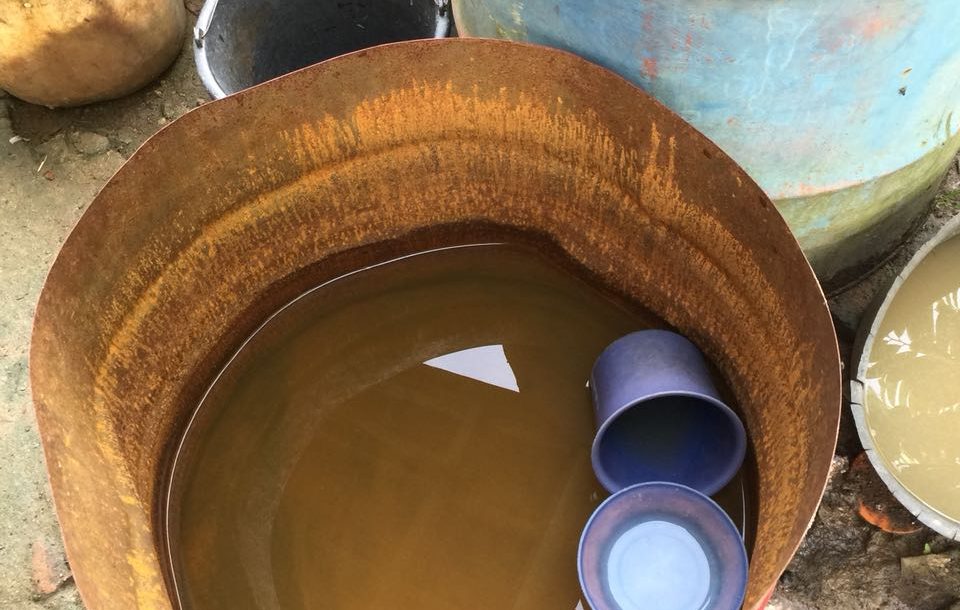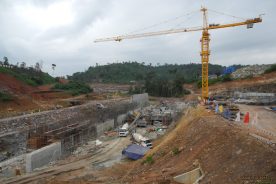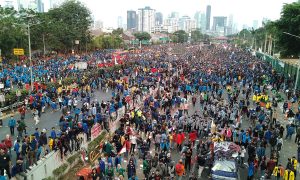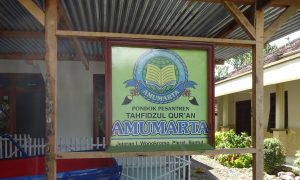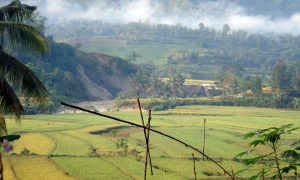The new Law no. 17/2019 on Water Resources in Indonesia reproduces the idea of the state’s role in ensuring access to water, by reasserting the state’s control and guaranteeing people’s access to clean water. The Law is a response to issues discussed in the 2015 Constitutional Court’s decision on the annulment of 2004 Law on Water Resources. The new Law shows that the state is convinced that private-based water providers and the narrative of water as an economic good are constraining the realisation of 100% access to clean water in developing countries.
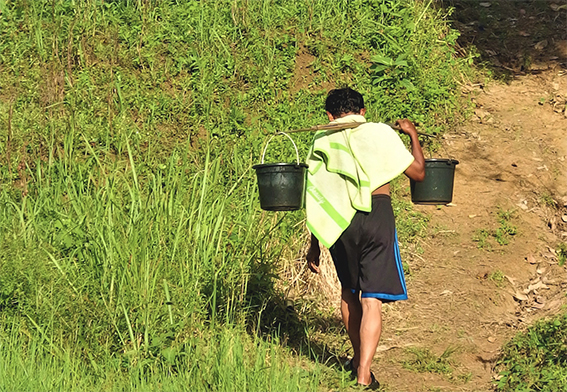
A resident in Picung Subdistrict taking water in small buckets from communal wells after using the sources for sanitation purposes. Photograph taken and supplied by the author
However, the day to day reality in rural areas of Indonesia shows otherwise. The singular role of the state in distributing water is not universally desirable. People in rural areas continuously work with other, or combinations of other, mechanisms of water provision.
According to my interview with sources at the State-owned Water Enterprise (PDAM) of Pandeglang District on Java, in 2017, they only supply 9.8% of the households in the district—most of which are in urban areas—and maintain a waiting-list of customers. Financial constraints on extending the networked pipeline and the inefficient operation of the enterprise have led to this limited coverage.
As a result, in rural areas, communities prefer to make use of two main mechanisms to fulfil their daily water needs: first, informal, private water providers; second, communal-based schemes relying on community labour. The most common schemes include private water tanks, water depots, rain-harvesting, and “worm-hose” water networks.
In the case of private water tanks, one owner revealed that they source the bulk water from local suppliers for IDR 15,000 (USD 1) per 5,000 litres, equal to 1 standardized tank, and sell the water to their customers between IDR 150,000 (USD 10) and IDR 650,000 (USD 44) per tank per delivery, depending on the distances.
This price is unaffordable for individual customers, hence several households usually pool their money for a single tank of clean water. Private providers also fill the gap left by subnational governments that are unable to connect households to the pipeline networked system, and who only provide water tank deliveries during the dry seasons. As the locals believe they have no other options, they are convinced they need to spend a relatively high amount to purchase water from these providers.
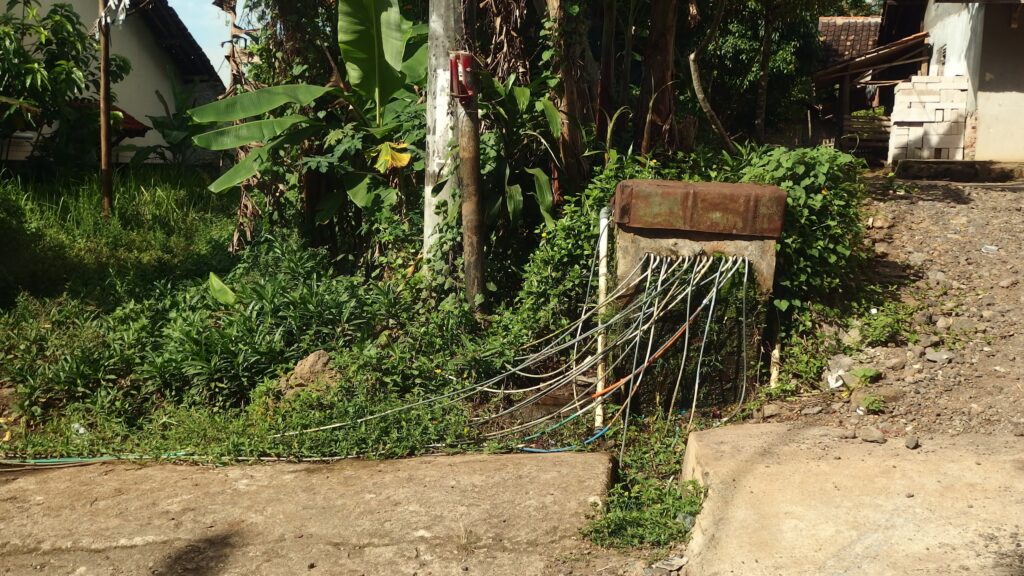
Private-based “worm” hoses that are omnipresent in Pandeglang District. Local communities are willing to purchase the water to a small, private provider and are channelling the hoses to their house to secure their daily access to water. Photo was taken and supplied by the author.
The worm-hose water pipeline is another case in point. In Cicadas village, reliable water providers are usually a community member who owns land with a water spring beneath it. Their neighbours, as customers, pay a monthly fee determined by the provider. The “worm”—a very small hose—connects spring water to neighbouring homes with supply hoses left disorganized on the surface.
The logic of water as an economic good applies to this mechanism and is organized by a household which typically is not categorized as private water distributors. There is no regulation to hold these providers transparent and accountable in calculating water prices. With a relatively low purchasing power, some households are unable to pay their bills on time. “There are no other options. Only this. We have to pay at whatever price. Since we have no other choice,” Mrs. Lilis, a resident of Cicadas Village, Pandeglang told me.
However, the providers, as fellow members of the neighbourhood, will not charge additional fees for late payments, and do not cut customers’ access to water regardless of their inability to pay on time. Locals are satisfied with the scheme and continue to rely on the mechanism to obtain access. Residents in the Cikupa area of Pandeglang also use a similar worm-hose system, even though PDAM could cover their area. However, residents prefer to use the worm-hose as the providers do not calculate charges based on metred usage, as is done through PDAM water infrastructure. Hasana, a resident of Cikupa, in Pandeglang asked: “Imagine if we use water from PDAM for 24 hours […] how much should we pay? PDAM’s water also often tastes like chlorine, and their access is often jammed. We need the system that can guarantee our sustainable access.”
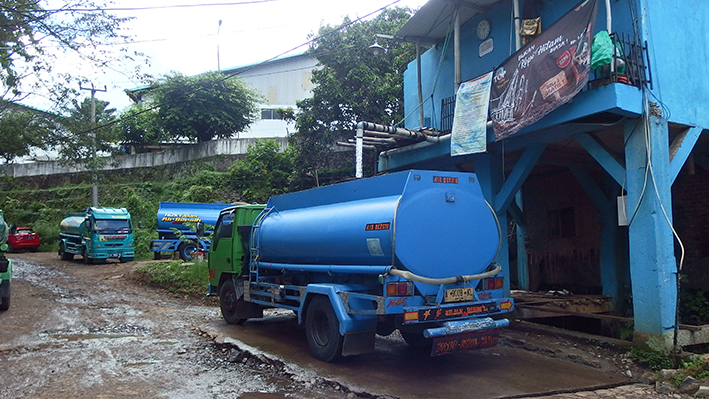
Water tankers in the bulk filling station, Pandeglang. Photo taken and supplied by the author.
In Picung and Sindangresmi subdistricts, remote rural areas where water resources are neither available nor accessible, locals practice household rain-harvesting in the rainy season. They store the rainwater in small barrels and utilize it either raw or boiled. Four seasonal infiltration wells provide water for the daily sanitary needs and subsistence of approximately 900 residents in the area. Otherwise, they rely on communal, temporary wells funded by money pooled at the beginning of the dry season. As the area is remote, water tankers are unable to reach the neighbourhood due to the poor condition of public roads. The lack of individual sanitation infrastructure also results in the absence of a reservoir for the locals to store a large amount of water from the tankers. “That’s how we get our water… what and who else we can get it from?” asks Ade, a resident in Picung Subdistrict, Pandeglang.
According to my observations, particularly in this area, the inability of locals to imagine alternatives derives from, among other sources, the state’s absence in water provision markets in their area. This results in the absence of any term referring to water access as a “right” in their daily conversations. They barely mention the state as an entity to which they might make demands, and perceive the existing mechanisms as sufficient.
These three cases illustrate that the role of private providers and communal works, or a combination of the two, are increasingly accepted and normalized among poor, rural communities. Instead of citizens whose rights should be guaranteed by the state, locals consider themselves to be customers who must buy water from private providers or rely on communal arrangements for water provision.
The absence of an official integrated map of water provision schemes that includes these provisions might be one fundamental factor constraining government’s intervention. As the data isn’t available, the government is unable to govern the private initiatives by understanding, among other things, what their underlying motivations are, how providers set prices, how they source the water they distribute and guarantee its quality, and to whom they deliver. There is no legal, formal mechanism to ensure they offer sustainable and affordable services on a long-term basis.
To govern these systems, the government needs to document and map localized, private and communal schemes and carefully define the boundaries of private and informal water provision.
The new Water Law has yet to facilitate this initiative. The Law states that water resources should be used to meet the basic daily needs of the people, smallholder agriculture, and business purposes. It focuses on permits for business entities with large water requirements, but not on the integration of privately owned water provision businesses into water distribution schemes. The law does not address day-to-day provision of clean water by private businesses. The role of these providers and this mechanism is absent from any water law policies.
Hydropower dams in Cambodia generate extensive processes of commodification and extraction, feeding the country’s vast shadow economy.
Rupture—hydropower dams in Cambodia as “engines of extraction”
Private water providers and communal infrastructure should be made visible and mainstream: they are in no way constraining the distribution of clean water resources. They should be acknowledged as empirically contributing to local water coverage and as alternatives to the limited state-owned pipelined networks. Their presence is embedded in the local neighbourhood and historical trajectories of obtaining water. Their contribution considerably shapes—maintains, expands, or reduces—the spatial inequality of water access in the rural areas.
Instead of coming up with new initiatives to extend household connections for people in rural areas, the government needs to support, engage and negotiate with, ongoing private- and communal-based providers. These schemes have their own logics and rules of governance that the government can learn from to advance the current system. Doing so will broaden water coverage and make it more rooted, sustainable, and contextually appropriate.
Findings in the article were part of a research project titled “Crafting Right-based Water Governance in the Southeast Asia: State, Market and Urban Poor”, conducted by the Department of International Relations, Universitas Gadjah Mada, funded and supported by SHAPE-SEA Research Grant Programme 2018 of Mahidol University, Thailand. The research team covers Dr Maharani Hapsari, Husna Yuni Wulansari, Taradhinta Suryandari, and Marselinus Saka.
 Facebook
Facebook  Twitter
Twitter  Soundcloud
Soundcloud  Youtube
Youtube  Rss
Rss 